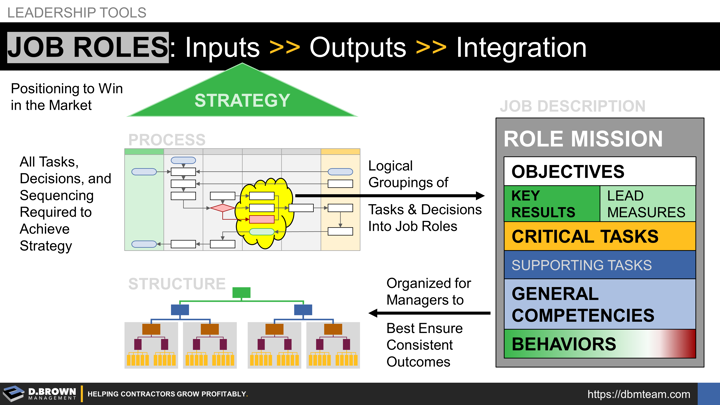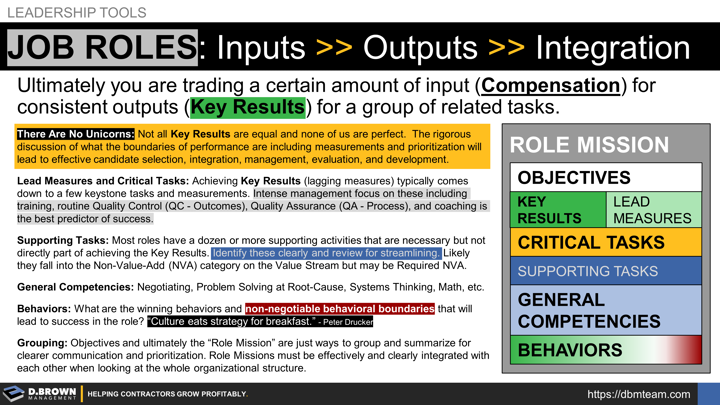In a job role, ultimately you are trading a certain amount of input (compensation) for consistent outputs (key results) for a group of related tasks.
Those inputs and outputs must work within the overall business model or else the job role isn't sustainable, impacting both the contractor and the individual.
Lack of clarity around job roles and responsibilities (job descriptions) translates to increased team stress, inconsistent results, and ultimately, a decline in all aspects of the contractor's scoreboard.
Role clarity will never be 100% but must continually progress toward greater levels of clarity at each stage of growth starting from the front-line. Clarity then progresses upward through all levels of management starting with front-line supervisors ensuring they are adding appropriate value to each person on their team and to the organization.
Effective job role descriptions cannot be created in a vacuum. Talent must be aligned across four basic layers starting with strategic choices.
Strategic choices are about defining what winning looks like and then putting the contractor in the strongest position to win.
Process is the integrated set of standards, workflows, tools, and procedures that will best support the execution of the strategy. Think about the building code, RFI, submittal, and change management processes that are relatively standard across the industry.
A job role is a logical grouping of tasks and decisions that are part of that process. Those groupings will evolve with growth of the business and projects. In general, the basic dimensions of grouping are:
- Level of Work - think about the typical education, experience, and capabilities required for consistent completion of the task or good decision making. Learn more about levels of work.
- Body of knowledge - examples include technical craft installation, engineering, contract management, construction accounting, safety, etc.
- Strengths - tasks and decisions require different core strengths such as high attention to detail or abstract creative thinking. Few people are good at both. Fewer are great at rapidly switching between the two. Even fewer truly enjoy both. Contact Sue Weiler-Doke to learn more about evaluating and leveraging strengths including how the fits into your Talent Value Stream (TVS).
- Proximity - this may be about physical proximity to a team or around customers both internal and external.
There will never be a perfect grouping and there are always trade-offs. These groupings evolve with growth of the business, changes in project size/scope, and as the talent density increases.
Now you have a job role with tasks and decisions grouped together - the job role responsibilities.
Key Results are your expected outcomes from each task and decision.
Objectives are what you expect to be collectively achieved by the job role through the combination of those tasks and decisions. Objectives and Key Results must be integrated throughout all parts of the company.
There Are No Unicorns: Not all Key Results, Tasks, and Decisions are equal and none of us are perfect. The rigorous discussion of what boundaries of performance are, including measurements, prioritization, and escalations will lead to effective candidate selection, integration, management, evaluation, and development.
Lead Measures: Achieving Key Results (lagging measures) typically comes down to a few critical tasks, decisions, and measurements. Intense focus on these including training, routine Quality Control (QC - Outcomes), Quality Assurance (QA - Process), and coaching is the best predictor of success. See cash flow example of leading and lagging measures.
Supporting Tasks: Most roles have a dozen or more supporting activities that are necessary but not directly part of achieving the Key Results. Identify these clearly and review for streamlining. Likely they fall into the Non-Value-Add (NVA) category on the Value Stream but may be Required NVA.
With headcount growth, it is very easy for nice-to-haves and well-meaning but stifling bureaucracy to creep into the company. Contractors who are most profitable due to momentum and high-growth markets are very susceptible to this.
General Competencies: These include things like negotiating, emotional intelligence, Root-Cause Analysis (RCA), systems thinking, math, etc. These may also be bodies of knowledge like a craft, engineering, accounting, etc. These general competencies support being able to complete the tasks, make the decisions, and achieve the objectives of the job role. Avoid a kitchen sink approach to this and really focus on which ones are truly required for success in the role.
Behaviors: These are the visible outcomes of a combination of a person's beliefs, values, and emotional regulation. Get very specific on these.
- What are the 3 to 5 specific behaviors that are most critical for your company's success?
- What are specific examples of each demonstrating the right behavior when the situation was tough?
- Who are your visible role models for these behaviors?
- What are your hard non-negotiable behavioral boundaries?
Your culture is defined by the worst behaviors knowingly tolerated by leadership. Permission is promotion.
The Mission Statement for the job role summarizes all these just like the mission statement for a company. Communicates why the role exists and how it aims to serve its customers - internal, external, and subordinates if applicable.
Those job roles are grouped and organized within a Management Structure to best add value through:
- Ensure both the right outcomes (Quality Control) and the right process is followed (Quality Assurance) to create consistent outcomes.
- Train team members to be competent with all tasks and decisions in their job role.
- Support the problem solving of each individual on the team.
- Provide context for how these tasks and decisions impact others.
Thorough job role descriptions are the foundation for:
- Interview guides, working tests, and other tools used to select the best candidates for the role.
- Integration plans to bring someone up to speed when transitioning into the role.
- Evaluations for current job role performance and aptitudes for other future roles.
- Development plans to increase performance in the current role and prepare for future roles.
Multi-Party Responsibility: Everyone is impacted when job roles aren't clear, including the individual, their teammates, their manager, and business as a whole. Know that creating clarity comes over time and requires consistent effort from all parties. Think about how the RFI process on a project is designed to create clarity. Review the requirements and ask "Good Questions" about anything that is unclear to you. Assume good intentions on everyone's part.
Recruitment Marketing is very different than the job role descriptions used to organize and manage the company. Job advertisements for recruiting must first and foremost attract the right types of candidates to the company while adhering to labor laws.


